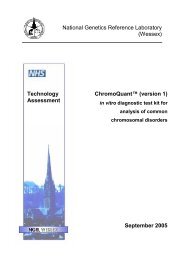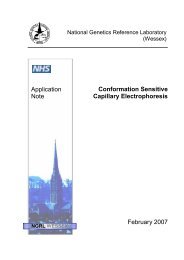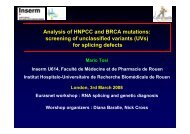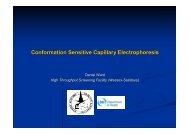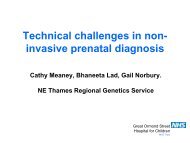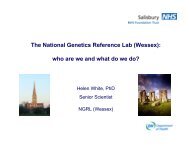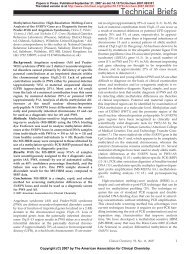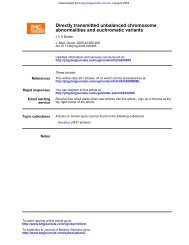Accurate Detection and Quantitation of Heteroplasmic Mitochondrial ...
Accurate Detection and Quantitation of Heteroplasmic Mitochondrial ...
Accurate Detection and Quantitation of Heteroplasmic Mitochondrial ...
You also want an ePaper? Increase the reach of your titles
YUMPU automatically turns print PDFs into web optimized ePapers that Google loves.
198reference peaks are also incorporated into the analysis thatadd confidence to the data collection. This provides additionalbenefit compared to PCR-RFLP or techniques that relyupon hybridization where false-positive <strong>and</strong> -negative resultscan be obtained in patients with polymorphisms that disruptthe hybridization or restriction enzyme sites or where incompleterestriction enzymes digestion can occur (e.g., Kirbyet al., 1998, White et al., 1998). The Pyrosequencing assayswere easy to design <strong>and</strong> optimise <strong>and</strong> sample processing <strong>and</strong>use <strong>of</strong> the machine were straightforward. The incorporation<strong>of</strong> new <strong>and</strong> existing mutations into mitochondrial point mutationscreening would be relatively undem<strong>and</strong>ing with theadvantage that the assays would not have to be designed toinclude restriction enzyme sites. The platform is very flexible<strong>and</strong> is amenable to the analysis <strong>of</strong> either individual mutationsin single wells or the analysis <strong>of</strong> multiple samplesfor the same mutation within the same run. This is anadvantage over PCR-RFLP where different, <strong>and</strong> sometimesmultiple, restriction digests are required for the analysis <strong>of</strong>each mutation. Pyrosequencing is more sensitive <strong>and</strong> rapidcompared to fluorescent PCR-RFLP with costings for eachtechnique being similar. We conclude therefore that Pyrosequencingis a robust, effective, <strong>and</strong> efficient means <strong>of</strong> detecting<strong>and</strong> quantifying mitochondrial mutations in a clinicallaboratory setting.REFERENCESBai RK, Wong LJ. <strong>Detection</strong> <strong>and</strong> quantification <strong>of</strong> heteroplasmic mutantmitochondrial DNA by real-time amplification refractory mutationsystem quantitative PCR analysis: A single-step approach. ClinChem, 50:996–1001, 2004.Boles RG, Chaudhari D, Soderkvist J, et al. Quantification <strong>of</strong> mitochondrialDNA heteroplasmy by temporal temperature gradient gelelectrophoresis. Clin Chem, 49:198–200, 2003.Chinnery PF, Howell N, Lightowlers RN, et al. Molecular pathology<strong>of</strong> MELAS <strong>and</strong> MERRF. The relationship between mutation load<strong>and</strong> clinical phenotypes. Brain, 120:1713–1721, 1997.Ciafaloni E, Ricci E, Shanske S, et al. MELAS: clinical features,biochemistry, <strong>and</strong> molecular genetics. Ann Neurol, 31:391–398,1992.Conley YP, Brockway H, Beatty M, et al. Qualitative <strong>and</strong> quantitativedetection <strong>of</strong> mitochondrial heteroplasmy in cerebrospinal fluid usingdenaturing high-performance liquid chromatography. Brain ResBrain Res Protoc, 12:99–103, 2003.DiMauro S, Schon EA. Nuclear power <strong>and</strong> mitochondrial disease. NatGenet, 19:214–215, 1998.Hancock DK, Schwarz FP, Song F, et al. Design <strong>and</strong> use <strong>of</strong> a peptidenucleic acid for detection <strong>of</strong> the heteroplasmic low-frequency mitochondrialencephalomyopathy, lactic acidosis, <strong>and</strong> stroke-likeepisodes (MELAS) mutation in human mitochondrial DNA. ClinChem, 48:2155–2163, 2002.He L, Chinnery PF, Durham SE, et al. <strong>Detection</strong> <strong>and</strong> quantification <strong>of</strong>mitochondrial DNA deletions in individual cells by real-time PCR.Nucleic Acids Res, 30:e68, 2002.Holt IJ, Harding AE, Petty RK, et al. A new mitochondrial disease associatedwith mitochondrial DNA heteroplasmy. Am J Hum Genet,46:428–433, 1990.Huoponen K, Vilkki J, Aula P, et al. A new mtDNA mutation associatedwith Leber hereditary optic neuroretinopathy. Am J Hum Genet,48:1147–1153, 1991.WHITE ET AL.Johns DR, Neufeld MJ, Park RD. An ND-6 mitochondrial DNA mutationassociated with Leber hereditary optic neuropathy. BiochemBiophys Res Commun, 187:1551–1557, 1992.Juvonen V, Huoponen K, Syvanen AC, et al. Quantification <strong>of</strong> pointmutations associated with Leber hereditary optic neuroretinopathyby solid-phase minisequencing. Hum Genet, 93:16–20, 1994.Kirby DM, Milovac T, Thorburn DR. A false-positive diagnosis for thecommon MELAS (A3243G) mutation caused by a novel variant(A3426G) in the ND1 gene <strong>of</strong> mitochondria DNA. Mol Diagn,3:211–215, 1998.Lagerström-Fermér M, Olsson C, Forsgren L, et al. Heteroplasmy <strong>of</strong>the human mtDNA control region remains constant during life. AmJ Hum Genet, 68:1299–1301, 2001.Liang MH, Wong LJ. Yield <strong>of</strong> mtDNA mutation analysis in 2,000 patients.Am J Med Genet, 77:395–400, 1998.Macmillan C, Lach B, Shoubridge EA. Variable distribution <strong>of</strong> mutantmitochondrial DNAs (tRNA(Leu[3243]) in tissues <strong>of</strong> symptomaticrelatives with MELAS: The role <strong>of</strong> mitotic segregation. Neurology,43:1586–1590, 1993.Mashima Y, Nagano M, Funayama T, et al. Rapid quantification <strong>of</strong> theheteroplasmy <strong>of</strong> mutant mitochondrial DNAs in Leber’s hereditaryoptic neuropathy using the Invader technology. Clin Biochem,37:268–276, 2004.Mashima Y, Saga M, Hiida Y, et al. Quantitative determination <strong>of</strong> heteroplasmyin Leber’s hereditary optic neuropathy by single-str<strong>and</strong>conformation polymorphism. Invest Ophthalmol, Vis Sci 36:1714–1720, 1995.Rahman S, Blok RB, Dahl HH, et al. Leigh syndrome: clinical features<strong>and</strong> biochemical <strong>and</strong> DNA abnormalities. Ann Neurol, 39:343–351,1996.Ronaghi M, Uhlén M, Nyrén P. A sequencing method based on realtimepyrophosphate. Science, 281:363–365, 1998.Santorelli FM, Tanji K, Shanske S, et al. Heterogeneous clinical presentation<strong>of</strong> the mtDNA NARP/T8993G mutation. Neurology,49:270–273, 1997.Silvestri G, Ciafaloni E, Santorelli FM, et al. Clinical features associatedwith the A G transition at nucleotide 8344 <strong>of</strong> mtDNA(“MERRF mutation”). Neurology, 43:1200–1206, 1993.Suomalainen A, Syvanen AC. Quantitative analysis <strong>of</strong> human DNA sequencesby PCR <strong>and</strong> solid-phase minisequencing. Mol Biotechnol,15:123–131, 2000.Szuhai K, Ouwel<strong>and</strong> J, Dirks R, et al. Simultaneous A8344G heteroplasmy<strong>and</strong> mitochondrial DNA copy number quantification in myoclonusepilepsy <strong>and</strong> ragged-red fibers (MERRF) syndrome by amultiplex molecular beacon based real-time fluorescence PCR. NucleicAcids Res, 29:E13, 2001.Tanno Y, Yoneda M, Tanaka K, et al. <strong>Quantitation</strong> <strong>of</strong> heteroplasmy <strong>of</strong>mitochondrial tRNA(Leu(UUR)) gene using PCR-SSCP. MuscleNerve, 18:1390–1397, 1995.Thornburn DR, Dahl H-HM. <strong>Mitochondrial</strong> disorders: Genetics, counseling,prenatal diagnosis <strong>and</strong> reproductive options. Am J Med Genet,106:102–114, 2001.Tully LA, Parsons TJ, Steighner RJ, et al. A sensitive denaturing gradient-Gelelectrophoresis assay reveals a high frequency <strong>of</strong> heteroplasmyin hypervariable region 1 <strong>of</strong> the human mtDNA control region.Am J Hum Genet, 67:432–443, 2000.Urata M, Wada Y, Kim SH, et al. High-sensitivity detection <strong>of</strong> theA3243G mutation <strong>of</strong> mitochondrial DNA by a combination <strong>of</strong> allelespecificPCR <strong>and</strong> peptide nucleic acid-directed PCR clamping. ClinChem, 50:2045–2051, 2004.Wallace DC, Singh G, Lott MT, et al. <strong>Mitochondrial</strong> DNA mutationassociated with Leber’s hereditary optic neuropathy. Science,242:1427–1430, 1988.Wallace DC. <strong>Mitochondrial</strong> diseases in man <strong>and</strong> mouse. Science,283:1482–1488, 1999.



